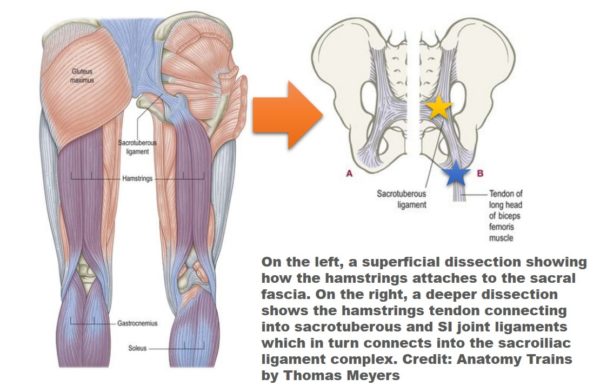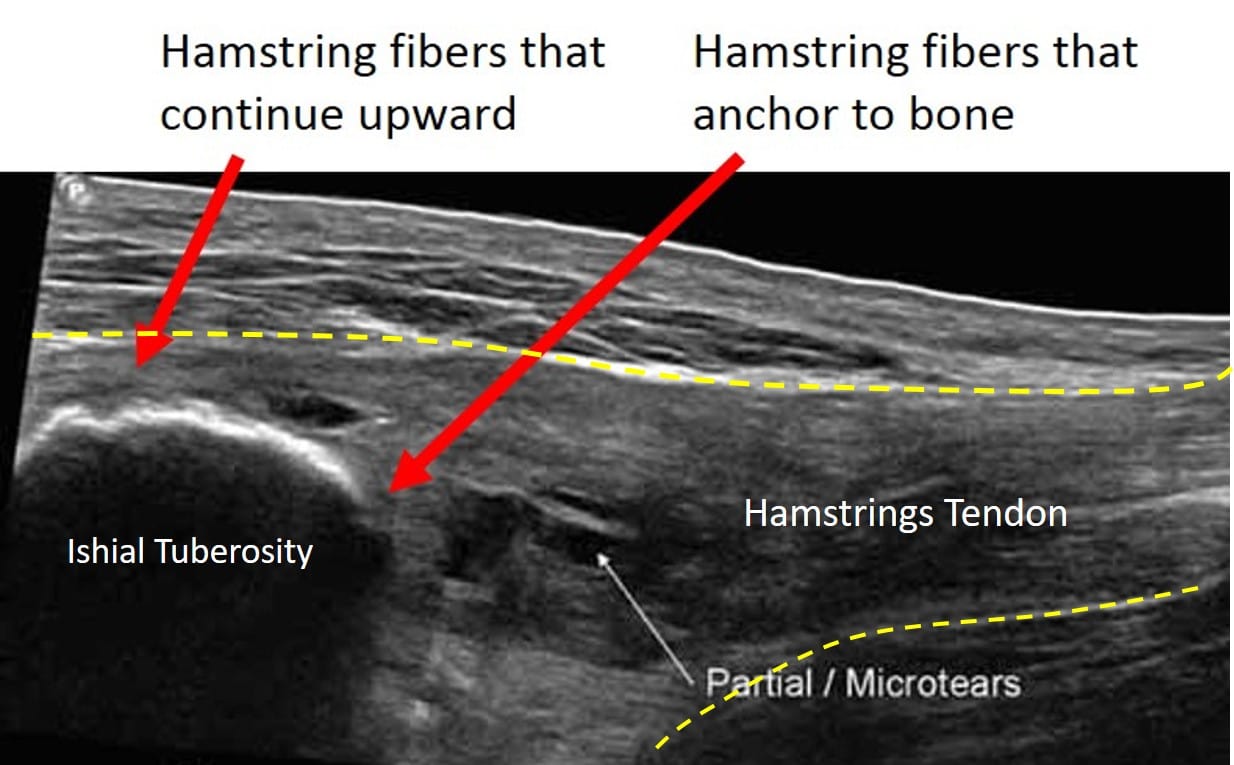Hamstrings Surgery Recovery? There Is No Such Thing as the Hamstrings
We all know the hamstrings muscle because, for many people, it’s usually tight. Or perhaps you know it because it’s always getting pulled. Or maybe you or a loved one has torn it and is worried about hamstrings surgery recovery. What if I told you the muscle doesn’t exist in the first place?
Every medical or health professional loves anatomy drawings. These beautifully rendered pictures show a sanitized version of how the muscles, joints, and bones connect that’s easy to understand. The only issue is that once you actually dissect a cadaver in medical school or look at these living structures under ultrasound imaging, nothing quite looks like an anatomy drawing. That’s because what you’ve been taught are separate structures are, in fact, all interconnected. Hence, there is no such thing as a hamstrings muscle, but it is, instead, a machine designed to transmit force from the spine to the ground that has a specialized and interconnected part that we call the hamstrings. Let’s explore that a bit this morning.
Your Interconnected Body
First, many of the illustrations that I’ll be covering come from the fantastic book by Thomas Myers called Anatomy Trains. If you want to understand how the musculoskeletal system works and leave the training wheels of anatomy drawings behind, this is the book for you. I have no financial relationship with this company but am happy to recommend an excellent read that will blow your mind!
As I said on other blogs, when you first begin to use musculoskeletal ultrasound, you immediately note a serious problem. What you’re taught in anatomy books and what you see are very different. As an example, take a look at this ultrasound image of the hamstrings in the image above.
First, to review, in traditional anatomy, every muscle has a place where it originates or anchors into a bone and where it inserts into another bone. In this way, discrete muscles are supposed to act like small machines that move two bones that are connected by one or more joints. For the hamstrings, one part of the muscle should anchor in the butt to the bone you sit on (called the ischial tuberosity) and insert down below the knee. However, as I’ll show you, that’s the simpleton version of the story.

Note that in the image above of the butt area, you see the ischial tuberosity where the hamstrings anchors. The hamstrings tendon is between the yellow-dashed lines. Now note that there are two types of hamstrings tendon fibers that even at this much-higher-than-MRI resolution can’t be told apart. Those that anchor the hamstrings to the bone (ischial tuberosity) and those that sail right past where the muscle should stop and continue upward. If you’re a student of anatomy, this is a real head-scratcher. Why are some fibers going up past their traditional anchor at the ischial tuberosity, and where do they end up? This quirk surely has to be an anomaly? Nope, we see this on every muscle that we image. These fibers that go beyond each muscle to somewhere else are why the concept of a hamstrings muscle in isolation is so silly.
Where do those hamstrings fibers go? To find out, take a look at these diagrams from Thomas Myers’s excellent book to the right. Note that the hamstrings fibers that bypass the ischial tuberosity (sit bone—blue star) head north to the SI joint (yellow star) through the sacrotuberous ligament. What you see then is that the hamstrings muscle anchors at both the ischial tuberosity and in the pelvis, which is the base of the spinal column. In fact, we can trace these “crossing fibers” (or what Thomas Myers calls an anatomy train) all the way up to the thoracodorsal fascia in the spine and then through various connections that lead all the way to the head! So what’s really going on is that the hamstrings muscle as we know it is merely one part of a more complex machine that transfers energy from the spine to the ground and vice versa. As a distinct entity, it doesn’t exist.
What Are the Treatment Implications of All of This?
When you have a hamstrings pull or tear, you need to understand that just one part of a bigger machine is failing. Hence, surgery to repair a tear may or may not be the answer as the tear usually represents a bigger problem. So worrying about hamstrings surgery recovery may miss the bigger question: why did this tear happen in the first place?
The next question now that you understand how all of this is interconnected is simple. Where else in the machine beyond the hamstrings are there problems? You may not know because MRI is simply not the best tool to look for tears in these crossing fibers. Ultrasound imaging has hundreds of times better resolution for this application. Also, many times we can’t detect small tears until we inject something using ultrasound guidance and observe the tear fill with fluid. In addition, now you can understand why problems in the spine can easily lead to issues in the hamstrings part of the machine. Also, since these connections go down to the foot, you can understand how issues there can result in problems in the hamstrings region.
What’s the Best Way to Treat Most Hamstrings Tears?
First, realizing that the hamstrings muscle is merely a link in a very interconnected chain changes which treatments would be preferred. Surgery is localized to one or a few spots and can be like a bull in the china shop of the body. However, precise injections of biologics can not only treat many areas at once but, as discussed, can be used as a high-accuracy probe to look for small tears in other parts of the interconnected system. In addition, while hamstrings surgery recovery can be protracted, the same is usually not the case with injection-based care, which has a much quicker recovery curve.
The upshot? Your body is interconnected, yet this fact has been all but ignored by modern orthopedics and radiology. Why? Orthopedics has focused on fixing one part, and hyperspecialization (i.e., the knee, foot/ankle, spine, and shoulder guy) has made things worse for recognizing and understanding this connectivity. Radiologists have depended on MRI imaging, which for things like tendons doesn’t have the resolution of ultrasound to allow these connections to jump out. Also, much of musculoskeletal radiology focuses on reading images for orthopedics and is, therefore, a self-fulfilling prophecy. However, you now know just how interconnected your body is, and armed with this knowledge, you can now begin to draw connections between your other parts and that nagging hamstrings!

NOTE: This blog post provides general information to help the reader better understand regenerative medicine, musculoskeletal health, and related subjects. All content provided in this blog, website, or any linked materials, including text, graphics, images, patient profiles, outcomes, and information, are not intended and should not be considered or used as a substitute for medical advice, diagnosis, or treatment. Please always consult with a professional and certified healthcare provider to discuss if a treatment is right for you.

